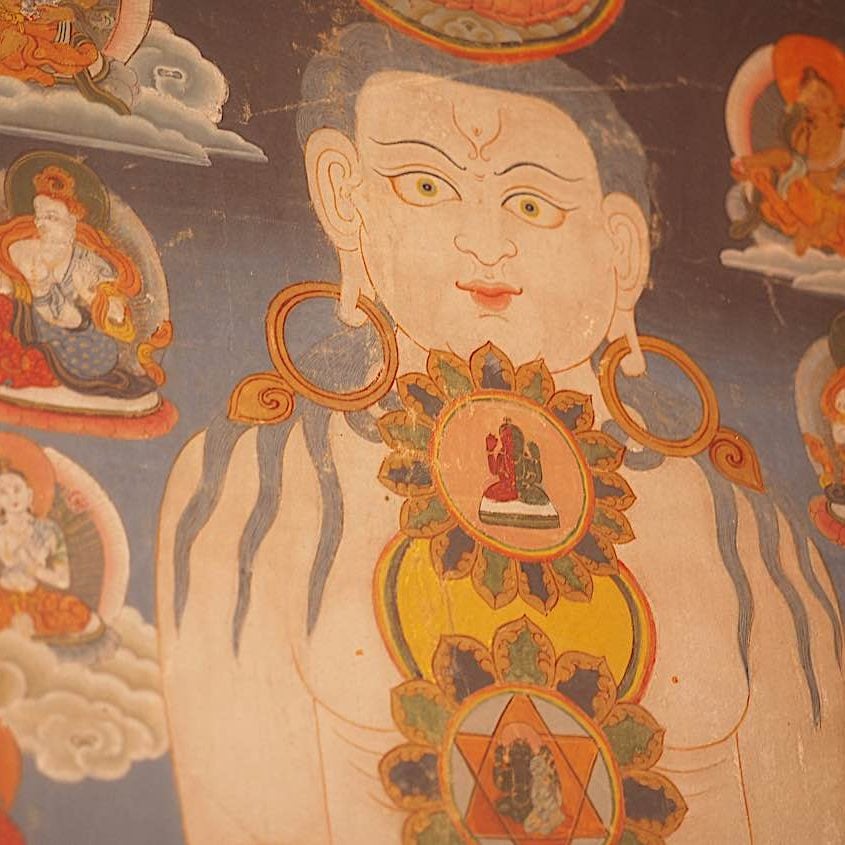Padmasambhava: “the source of accomplishment is the Yidam”; Yidam is systemized practice, not just a “deity”
“The source of blessings is the lama, the source of accomplishment is the yidam, and the source of activities is the dakinis.” — Guru Rinpoche Padmasambhava
Yidam is a method — usually a defined system of practices — rather than just a “deity” — as clearly stated by the great Lotus Born master. The over use of Yidam to mean “heart deity” rather than “heart method” is misleading, an important distinction lost on sites such as Wikipedia, where the Yidam is asserted to be a “cherished deity.” Yidam is usually a very complete system of practices focused on a single deity (with symbolism related to those practices), rather than a deity with some practices. The Great Lotus-Born Padmasambhava also said,
“These vast collections of practices can be condensed into those of the three roots, lama, yidam, and dakini.”
In Mahayana Buddhism, generally, the three roots would be Buddha, Dharma and Sangha — which have similar associations. Buddha is teacher, Dharma is the method and Sangha carries out the Activities. In Tibetan Buddhism, the Teacher is Lama, the Method is Yidam practice and the Activities are carried out by the Dakinis (or Khandro.)
- From the book Dakini Activity [1] by Padmasambhava, on Amazon (affiliate link)>> https://amzn.to/3nCSwVo

Yidam is much more than an enlightened deity
Padmasambhava’s teachings profoundly shifts the focus of Yidam from “deity” to “practice.” Devotion to a “deity” is only a small facet of the Yidam — in fact, devotion is how we start and end the practice; in between, are normally a very focused system of “yogas.” Even the appearance of the Yidam is emblematic of the Yidam practice. Four faces, twelve arms, and various attributes and symbols become iconic of the system. For example, the 11 Yogas of Naropa practiced with Vajrayogini is a complete system — and every symbol and attribute in her mandala means something in the context of the Yogas.
For this reason, the Yidam, alone, as an icon of devotion, is very clearly meant to represent a systemized practice. (Certainly, if you say, Yidam Deity, you can assert it is the “deity”, but Yidam, as a word, refers to the “method of accomplishment.”) Each of Yamantaka’s many hands and legs means something in the context of the system. Every color identifies an activity focus.
Yidam is a contracted form of the Tibetan yid kyi dam tshig and is the bundle of practices (yogas) associated with our samaya (commitments). Yid literally means “mind” Yid kyi dam tshig translates as: “samaya of mind.” Many of us, have used the word Yidam as synonymous with the Enlightened deity associated with that cherished practice — strictly, speaking an incorrect morphing of the word. We certainly could say “Yidam deity” to mean the commitment deity, but Yidam, as a single word, strictly refers to the practices associated with that deity.
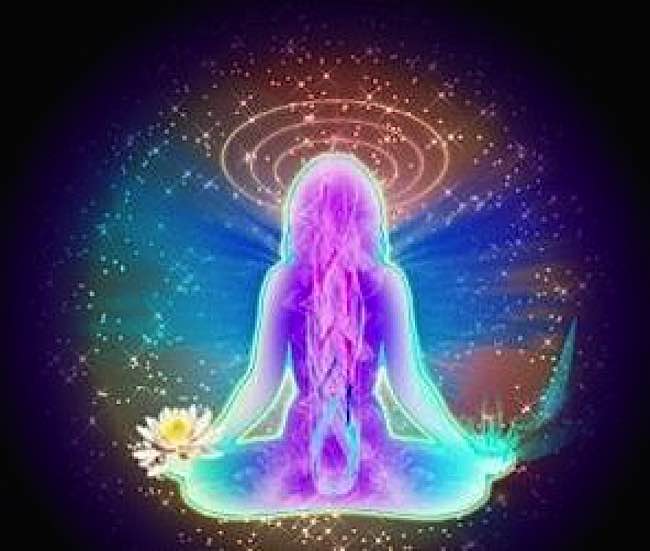
Yidam is our heart commitment
The defining characteristic of Yidam is Oneness: we choose one practice, a cherished practice for life, as given to us by our teachers, with a proven lineage, as a means to accomplish the goal of Enlightenment for the benefit of all sentient beings.
We may, at various times, practice various yogas, but our central, lifetime commitment is to the Yidam (a single practice system.) Once chosen, it’s fair to say that your one Yidam then becomes the focus of your practices.. When you practice your Yidam — regardless of which one — you are practicing all Enlightened forms. This is why we have a little fun with the Lord of the Rings and the One Ring below (non-fans, just skip it!)
The incomplete definition of Yidams on Wikipedia and other non-practice oriented sites can lead to confusion. (Hint: Yidam is much more than the deity!) Using the word Yidam as a “noun” to describe your cherished, personal deity is confusing, especially for new Vajrayana Buddhists.
This became clear to when we received this comment on the video “How to choose a Yidam” (embedded below) “Can I make Shakyamuni Buddha my Yidam?” It’s a beautiful sentiment, but it was clear Yidam was being interpreted as the actual deity, which is not quite the meaning of “Yi, meaning “heart” and “dam” meaning “commitment” and “means.”
Venerable Zasep Rinpoche — short teaching on how to Chose and visualize a Yidam:
It is clear the word Yidam is being assumed to mean “deity” by many of us — which leads to a lot of confusion. Yidam is much wider than deity. Yidam is the heart practice that you devote your life to (Yi is “heart” and “dam is “commitment”).
You commit your life to practice with the goal of ultimate enlightenment. Deity is one aspect — one of a dozen aspects — of Yidam. The commitment is to an entire system of meditational practice. In fact, in a Yidam practice, there can be (often) multiple deities.
Vajrasattva as Yidam — practicing the perfection of purification, video:
“Means of Accomplishment”
The shortest, meaningful definition of Yidam would be “means of accomplishment” — since Yidams include a full cycle of practices. What are we trying to accomplish? Transformation and Enlightenment. We don’t need multiple Yidams, because each Yidam is a complete transformative means of accomplishing the ultimate goal of Enlightenment. Mixing multiple methods is usually discouraged, not because you can’t have more than one Yidam, but because it’s confusing to do so.
Yidam, in the context as given by a teacher, are a bundle of practices — used as our “means of accomplishment — that we commit to, revolving around a personally-cherished deity or mandala with a full-system of yogas. Why mandala? Because some Yidam practices involve multiple deities. Nor are these deities limited to one form. Why cherished? Because we are committing to practice the Yidam for life.

A typical series of “yogas” or practices found in a single Yidam practice might include:
- Taking Refuge in the Three Jewels
- Bodhichitta practice
- Vows
- Guru Yoga
- Praising the lineage
- Self-generation of the deity
- Offerings: mandala, Bodhichitta, sense offerings, inner, and others
- other unique practices as guided by teacher and commentary from the lineage of accomplishing masters.
Contracting “Yidam deity” to “Yidam” — as done on various online encyclopedia sites — leads others to think the word Yidam is no more than our personally cherished form of the Enlightened Buddha (or deity)— a devotional deity in other words. Although we are devoted to our Yidam deity, this is not the correct or complete definition of Yidam (It’s the definition of Yidam Deity, however — confusing, isn’t it?) The Yidam must be associated with a complete system as a “means of accomplishment.”

Ishta Yoga or Cherished Practices
Ishta Yoga means Cherished Practices (more or less) in Sanskrit. Meanwhile, “Yidam deity” in Sanskrit is Ishta-deva or devata (Sanskrit: इष्टदेवता). However, notice Ishta-Deva is the equivalent of Yidam Deity, not Yidam. Ishta literally means “cherished.”
Yidam as a contracted form of the Tibetan yid kyi dam tshig is the bundle of practices associated with our samaya (commitment) deity — unless you’re in the habit of contracting “Yidam deity” to Yidam. Is this being picky? Not at all, judging by comments on a recent Youtube video on Youtube (see below.) Incomplete or contracted definitions confuse new students. They tend to think “Yidam” is nothing more than the word “cherished deity” instead of a bundle of practices bound by commitments, usually associated witth one or more deities. It’s is extremely confusing if you say your Yidam is 62-Deity Chakrasamvara. There are 62 deities in this practice. In other words, think “mandala” rather than deity — but even then, that’s not the definition.

Incomplete definitions online: Yidam is much more!
This is not helped by Wikipedia’s incomplete high-profile definition: “Yidam is a type of deity associated with tantric or Vajrayana Buddhism said to be manifestations of Buddhahood or enlightened mind,”— which is incomplete to the point of being misleading.
The Tibetan Buddhist Encyclopedia has more correct definition: “the focus of personal meditation or retreat for life.”
They further conflate the definition by giving the synonyms “meditational deity” — again not incorrect, just misleading in its incompleteness. Yes, the Yidam deity is part of the Yidam, so it’s not entirely incorrect — but this incomplete definition leads to many misunderstandings.
In other words, practices. Of course the deity is the subject of the practices, but the practices become forgotten in the quest for various empowerments. Empowerments only empower you to practice. Without practice, they are certainly not Yidam. Your central “practice” — is your Yidam. Practice means you practice it, are devoted to it with all your heart, and committed to it by samaya with your teacher. Normally the practice can include several yogas, up to 11 — for example in Vajrayogini practice.
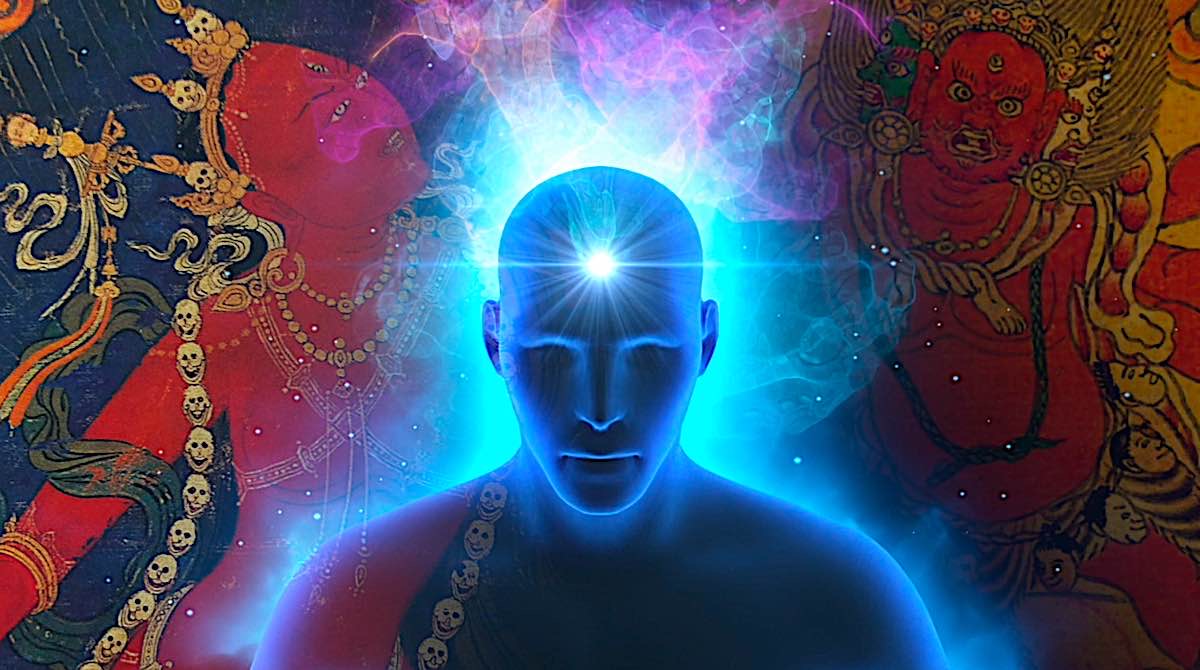
Later, the definition comes closer, when they write:
“Examples of yidams include the meditation deities Chakrasamvara, Kalachakra, Hevajra, Yamantaka, and Vajrayogini, all of whom have a distinctive iconography, mandala, mantra, rites of invocation and practice.” It would be more correct to say “Yidams are a practice with a specific meditational deity, iconography, mandala, mantra, practices.”
Unless you say “Yidam deity” the word Yidam by itself is meant to describe the “teacher-guided practices of a personal meditational deity to which you commit for life.”
![Padmasambhava: "the source of accomplishment is the Yidam"; Yidam is systemized practice, not just a "deity" 7 The highly respected Gelug master, Tulku Drakpa Gyaltsen, (1619-1657) — an incarnation of Manjushri and Mahasiddha Virupa — advised that we should all practise the sadhanas of Vajrapani, Hayagriva and King Garuda and make offerings to the Nagas. The Naga offerings are important because our world is suffering through ignorance, greed, politics and lack of respect for the environment. We make offering to the Nagas to help to heal our water systems which are contaminated; we all suffer from long droughts, abnormal rainfall, and a shortage of good water. There are all kinds of climate problems and the world weather patterns are changing rapidly. Who are the Nagas? According to Sutras and Shastras Nagas are classified as beings of the animal realm. For most Nagas, the upper half of the body is human and the lower half is like a serpent or fish. They have beautiful human faces and wear jewelled crowns and beautiful ornaments such as earrings, necklaces and so on. Male Nagas can be powerful and handsome looking and female Nagas are beautiful and attractive. Some N agas possess great powers , similar to the gods. The Naga realm is said to be under the oceans and seas. As well, Nagas can live in lakes, rivers springs, creeks, or marshland. Nagas also reside in trees called Naga trees. According to the famous Tibetan scholar, Dungkar Losang Thinley Rinpoche’s encyclopedia, most of the Nagas are wealthy. They wear most expensive jewels and ornaments and silk scarves; they have a good life. The Nagas are divided into different classes and have various kings and queens and chieftains. There are eight great Nagas: Blue Thaye sits in the east; Red Jokpo sits in the south; Green Tob Gyu sits in the West; multi-coloured Rigden sits in the north; Norgye sits in the southeast, Pedma sits in the northwest, Dung Kyung sits in the southwest, and Varuna sits in the northeast. Many Nagas are very intelligent and they are able to practise Dharma , some have obtained Dharma realizations. Some of the Naga kings and queens vowed to the Lord Buddha to provide the right causes and conditions of Dharma practice for human beings. They provide the conditions for the preservation of Dharma so that Dharma can flourish. It is difficult to imagine that the Nagas 2 3 are classified as beings of the animal realm considering their intelligence and devotion to Buddha, Dharma and Sangha. When Lord Buddha was practising on the path to enlightenment for six years under the Bodhi tree, the Nagas made snake umbrella hoods above his head to protect him from the sun and rain. According to Mahayana sutras, when Mahayana Buddhist teachings were declining in India due to Karmic circumstances, the Naga Kings took the teachings and texts to Nagaland to save them until the right teachers emerged who could reveal the teachings on earth again. Nagarjuna (c.150–c. 250) was a great Indian Buddhist philosopher who composed and taught six major texts on emptiness (Shunyata) and is traditionally regarded as the founder of the Madhyamika (Middle Way) school, an important tradition of Mahayana Buddhist philosophy. He is considered one of the most important of all Buddhist philosophers. According to tradition, he was born in south India, and then travelled to the land of the Nagas and re- introduced Mahayana teachings to humans on earth. We as human being should support Nagas and help them by protecting the natural environment which is home for human and Nagas; we are all dependent on each other for our survival. If we harm the environment, and cause pollution due to our greed and ignorance, then Nagas will get sick. They may also become angry and while they won’t harm us directly, the harm could come to us because of pollution of water and food sources. It is important we humans respect the environment for the benefit of all beings. My father told me and my brother that if you find copper or gold nuggets while hiking in the mountains, don’t just take them without showing gratitude to the spirits of the earth. You must offer food like grain, as a replacement, and show appreciation to the Zidak mountain spirits and Sadak earth spirits. If you feel you harmed the Nagas then make special offerings called Lu Men, Naga You can obtain Lu Men - Naga medicine from the traditional sources. Torma offerings for the Nagas There are two kinds of Tormas: regular Tormas you place on the altar and the second kind, which are dough balls you can arrange on the table in front of you. The Naga Tormas are made with Tibetan Tsampa (roasted barley flour) 4 with the addition of the three whites: yogurt (curds), milk and butter. Then add the three sweets: honey, sugar, molasses or brown sugar. Do not use any animal flesh or meat products, and don’t use spices such as chilli or garlic. Special Torma dough balls are placed in a small bowl on a tripod placed inside a larger bowl. Fill the bottom of the larger bowl with water. Offer water by pouring it onto the dough balls in the small bowl. The overflow will remain in the large bowl. (See the photo of Kyabje Zong Rinpoche making dough ball Torma offerings with water on Page 1.) Requirements for the Naga Puja offering Torma offering and dough balls made with pure water, three whites and three sweets, as explained above. A tripod on which is placed a plate or a small bowl. A pitcher to fill the water bowls. Two sets of seven offering bowls for the altar. Action vase - Bumpha - with saffron water consecrated previously Five-coloured cloth of silk or cotton as a decoration Tingsha (small cymbals) for the music offering Preparations for Naga Puja Firstly, we practise the sadhana of Avalokiteshvara, guardian and patron Buddha of the six realms, the most compassionate Buddha. Torma Offering to the Nagas - Lutor By First Panchen Lama Translated and adapted by Zasep Tulku Losang Tenzin Gyatsen Namo Guru Avalokiteshvara Offerings to Avalokiteshvara should be placed on the altar, Torma and two sets of seven bowls, cakes, fruits and flowers, incense and so on. Special Torma offering for the Nagas should include two sets of offering bowls, and offerings such as three whites (curds, milk, butter) and three sweets (molasses, honey and sugar ) five different colours of silk, jewel, grains, medicine for the Nagas inside a tray, set up on a nice altar. Preparatory Practice: Sadhana of Avalokiteshvara Taking Refuge and generating Bodhichitta I take refuge in the Buddhas, the Dharma and the Supreme Sangha, Until I attain Enlightenment. By the merit I accumulate from practising generosity and the other perfections, May I attain Buddhahood in order to benefit all beings. The Four Immeasurable Attitudes May all beings have happiness and its causes May all beings be free from suffering and its causes May all beings never be separated from the joy transcending sorrow May all beings dwell in equal love for those both close and distant. [x3] Now confirm the Emptiness of all phenomena in and beyond cyclic existence by means of the following mantra: OM SVABHAVA SUDDHA SARVA DHARMA SVABHAVA SHUDDHO HAM Everything becomes empty. Self-generation as Avalokiteshvara 5 Within the sphere of Emptiness appears the letter PAM. It transforms into a white lotus upon which is the letter AH. AH becomes a moon-disc. At its centre is my own mind in the form of a white letter HRIH. HRIH emits light-rays, which work for the benefit of living beings, transforming them to the state of Arya Bodhisattvas. The light-rays return into the letter HRIH. The HRIH transforms, and I arise from it as the Arya Avalokiteshvara. I have a snow-white body, one face and four arms. My front pair of hands is clasped together at my heart. My second right hand holds a crystal jewel mala of one hundred and eight beads. My second left hand holds a lotus which blooms beside my left ear. I sit in full lotus posture. I am adorned with eight precious ornaments on my head, ears, throat, hands, and feet. I wear silk garments and have an entrancing, serene smile. A white OM syllable marks the crown of my head, a red AH my throat, and a blue HUM my heart. Also a white HRIH syllable sits at the centre of a moon-disc in my heart. DZA HUM BAM HOH Inviting and Absorbing the Wisdom Beings into Oneself The HRIH radiates lights, inviting the mighty Arya Avalokiteshvara and his retinue of Buddhas and Bodhisattvas from their southerly abode. They absorb into me and thus we become one. DZA HUM BAM HOH Requesting and Receiving Empowerment Again lights go forth from the HRIH at my heart, inviting the Empowering Deities. I request them: ‘Please grant me empowerment’. Thus requested, they raise aloft vases of wisdom nectar. Saying OM SARVA TATHAGATA ABHISHEKATA SAMAYA SHRIYE AH HUM They initiate me with their nectars. The nectar fills my body, purifying all my defilements. The excess nectar overflowing on the crown of my head transforms into Amitabha Buddha, who becomes my crown ornament. Now make outer offerings to oneself as Avalokiteshvara which clears interferences, purifies, and invokes blessings: 6 Presenting Outer Offerings to Oneself as Self-generated Avalokiteshvara OM ARYA LOKESHVARA SAPARIVARA ARGHAM PRATICHA HUM SVAHA OM ARYA LOKESHVARA SAPARIVARA PADYAM PRATICHA HUM SVAHA OM ARYA LOKESHVARA SAPARIVARA PUSHPE PRATICHA HUM SVAHA OM ARYA LOKESHVARA SAPARIVARA DHUPE PRATICHA HUM SVAHA OM ARYA LOKESHVARA SAPARIVARA ALOKE PRATICHA HUM SVAHA OM ARYA LOKESHVARA SAPARIVARA GANDHE PRATICHA HUM SVAHA OM ARYA LOKESHVARA SAPARIVARA NAIVIDYE PRATICHA HUM SVAHA OM ARYA LOKESHVARA SAPARIVARA SHABDA PRATICHA HUM SVAHA Praise to Oneself as Avalokiteshvara White in colour, untarnished by faults, Amitabha Buddha embellishing the crown of your head, You look upon living beings with overwhelming compassion, To Chenrezig I humbly bow down. Mantra recitation and meditation OM MANI PADME HUM x108 water for drinking water for washing flowers incense light perfume food music Visualising myself as Avalokiteshvara , at my heart appears a circular white moon-disc, upon which is my own mind in the form of a white HRIH syllable. At the edge of the moon-disc stand the six syllables of the mantra OM MANI PADME HUM. They are resplendently white like the rays of the rising sun. Light comes forth from the mantra syllables, filling my whole body, purifying all my negativities and obscurations. The light-rays then leave through the pores of my body and purify the negativities and obscurations of all living beings. They are transformed into mighty Arya Avaloketishvara. My threefold manner of perception involves seeing all external appearances as rainbow-deity forms of the mighty Arya Avalokiteshvara; all sound is heard as the six syllable mantra; and mind is imbued with essence of method conjoined with wisdom, which is the great compassion focused on all living beings and the wisdom understanding Emptiness, the wisdom which clearly perceives that all phenomena in and beyond cyclic existence lack even a particle of inherent existence and are mere imputations. 7 8 Thus visualising oneself as Avalokiteshvara, melded within this threefold perception, one recites the MANI mantra. From the energy of the practice living beings of the six realms of samsara obtain the Enlightened form of Arya Avalokiteshvara. Moreover, in the manner of a full sesame pod, the entire earth, air, and sky are filled with the form of Avaloketishvara.Their combined chanting of OM MANI PADME HUM releases the sound of the MANI mantra like a crescendo of thunder. Yet just OM, having the threefold aggregate of A-U-M, signifies the three indivisible adamantines of my body, speech, and mind. This mantra is called The Jewel Holder, for a single recitation with such understanding is meritorious. Thus OM begins the mantra. MANI means jewel. PADMA means lotus, whereas PADME denotes supplication. So with my heartfelt entreaty to Avalokiteshvara, the Jewel in the Lotus, I recite the mantra while dwelling on contemplations such as the fusion of the mighty Arya Avalokiteshvara’s qualities within me. Furthermore, the respective six syllables cut off the doorways to rebirth in the six realms of samsara. The six syllables are also the consummation of the six perfections. Thus the MANI mantra, having these and other excellent qualities, is held to be of endless advantage and significance. Moreover the mighty Arya Avalokiteshvara is said to be in general the quintessence of all the Buddhas’ compassion, and in particular, the patron Buddha of Tibet. Therefore one should strive with enthusiasm in the recitation, cultivating Avaloketishvara as a most excellent meditational deity with these special characteristics. The main Sadhana of Naga Torma offerings Blessing the Torma and offerings to the Nagas OM VAJRA AMRITA KUNDALI HANA HANA HUM PHAT OM SVABHAVA SHUDDHA SARVA DHARMA SVABHAVA SHUDDHO HAM . While in the sphere of voidness, from BHRUM syllables arise vast and deep vessels made of precious materials, within which are the eight offerings, the Torma, and all conducive sacred ingredients, along with the syllable OM and a syllable formed by the initial syllables. They all transformed into wisdom nectar. They become medicine that purifies pain and suffering. Also multitudes of wish-fulfilling jewels provide us whatever we wish for —a marvellous secret landscape of palaces. In short whatever sublime 9 enjoyments the Naga Kings and queens and their children and attendants desire. OM SVABHAVA VISHUDDHE DHARMATE VAJRA SIDDHI HUM NAMAH SARVA TATHAGATE BHYOVISHVA MUKSHEBHYAH / SARVA TAD KHAM UDGATE SPHARANAHI MAM GAGANA KHAM SVAHA OM AMRITE HUM PHAT OM AKARO MUKHAM SARVA DHARMAH NAM ADYANUDPANNE HA TA NAMAH SARVA TATHAGATA AVALOKITE OM SAMBHARA SAMBHARA HUM OM RURU SPHURU JVALATIKSHTHA SIDDHI LOCHANI SARVA ARTHAM SADHANI SVAHA OM ARGHAM AH HUM OM VAJRA PUSHPE AH HUM OM VAJRA DHUPE AH HUM OM VAJRA ALOKE AH HUM OM VAJRA GANDHE AH HUM OM VAJRA NAIVIDYA AH HUM OM VAJRA SHAPTA AH HUM Invitation for general guests In the space in front of me, visualize a natural stone made of jewels with a large or small golden coloured caves, below which are Naga palaces and Naga pleasure groves, lakes, ponds, pools, meadows adorned with flowers, springs, wells, waterfalls, flowing water in the lakes, and grassy plains and parks, as well as a jewel palace, everything arranged naturally most beautifully. Inside is the N aga king Varuna, their chief, the eight Great Naga Kings, and Queens, the entire assembly of Nagas and Bumi Putras and Putiris of the earth lords and earth caretakers, along with their retinue. Bless the Tingsha-cymbals by reciting OM PADMO USHNISHA VIMALE HUM PHAT (7x) Then play cymbals three times Now make invocation to the Naga Kings by emanating lights from HRIH syllable for my heart The light rays shine, From your fabulous jewelled hood, Dispelling all the darkness of the underworld; You who delight in the Teaching of Lord Buddha, incomparably powerful ones, Naga kings without exception, come here with your retinue! Actual offerings OM NAGA RAJA SAPARIVARA EH HYE HI SAMAYA JAH JAH / JAH HUM BAM HO / PADMA KAMALA E STVAM NAGA RAJA SAPARIVARA ARGHAM /PADYUM /PUSHPE / DHUPE / ALOKE /GANDHE /NAIVIDYA /SHAPTA) PRATICCHA HUM SVAHA Make the Torma ball and water offering to the Nagas while chanting the following paragraph While I am self generated as Avalokiteshvara, from the palm of my hand, nectar merged with milk flows continuously like a stream transformed into the Torma materials and precious holy substances of various medicines, generated by transcendental wisdom like a great ocean of desirable objects visualized in front of me. The guest Nagas enjoy this. The effect of the healing is tremendous, it renewed limbs, and organs are healed. Pain and suffering are eliminated, and minds experience fulfilment with uncontaminated bliss. Thus while visualizing my self as most compassionate Arya Avalokiteshvara pour the holy water from the vase onto the offering Torma balls inside the bowl with the right hand at the same time snap with the fingers of my left hand once for each mantra recitation. Mantra to bless the Mala OM RUCHI RAMANI PRAVATAYA HUM [x7] 10 Main Mantra !" #$%&%'%()%*+%,%-" OM VASUKI MAM SVAHA [ x 108] You are the lord of the assembly of Nagas Light shines from your jewel hood Bestow the supreme siddhi of everything desirable I bow down to you, Varuna. Ananta and Takshaka (Thaye and Jogpo) Karkotaka and Kulika (Tob kyi gyu and Rigden) Vasuki and Shankhapala (Norgye and Dung Kyung) Padma and Varuni (Pedma and Chu Lha) Nanda and Delight ( Gawo and Nyer Ga wo) Ocean and Great Ocean, Glorious light and Great Radiance, Great Bodied One, good serpent Mahabala, Naga Kings and your retinue, Come here to enjoy this decorated Torma. The offering of the exquisite three whites and The three sweets, a swirling ocean of milk And beautiful jewelled stairs. May this become whichever conducive substance Protects for the suffering of the nagas. Enjoy the offering gifts and Torma, For us practitioners, the benefactor and retinues. All four hundred and twenty four diseases and The diseases of Nagas due to their own Karma Visible poison and touchable poison, Poison caused by bad thoughts and of vapours arising from the mouth, Intentionally caused by humans, and so forth, May all be soon pacified without exception. I offer these treasured substances from us: Cause and condition of all Naga disease to be eliminated, The four-siddhi actions of enlightenment, Increased wealth and prosperity. 11 If you wish to practise this sadhana on a daily basis for the healing of sick people then visualize an ocean-like medicinal nectar arising to cure all the diseases of Nagas and earth lords and earth owners. In this way it will be providing healing modalities for human beings and the Nagas at the same time. May injury of the inner organs, stomach, flesh, and blood Be healed by the King of Medicines, the six fabulous medicines for maintenance of the body (nutmeg, clove cubeb, cardamon, saffron, and bamboo pith). May deteriorated teeth, bones, and tongue Be healed by using cowrie shells and red silk. May our bones’ lustre be restored By magnificent peacock feathers with the eye design, Also five-coloured silks used as part of the ritual, Fruit of Kyema Shosha will purify and Heal disease of heart, kidneys, and lungs. May damage of the limbs and other parts of the body be healed By herbs of Latifolia like Oxalis, Ulmus minor and Vitisvinifera, Powerful hand-claws of fresh water or salt water Crocodile. May impaired arteries, nerves, tendons, and muscles Be healed by using powerful herbs and minerals like The fragrant root of andropogon muricatus, and Medicinal stones such as gray antimony. Incense made with sage and juniper and so on, Polygonum aviculture, Ji-thangka medicinal fruit (effective against worms) The three fruits and assortment of medicines, and Bubbles from the ocean waves, will restore skandhas and dhatus. By the five precious minerals and varieties of grains, Your treasure house will be restored. The three whites (curds, milk, and butter) and the three sweets (molasses, honey and sugar ) will restore bad complexions. In short, may the power of conducive medicinal substances Heal the sickness and sorrow of Naga and earth owners. 12 May their sense faculties be clear and properties increase, And love and compassion fill their minds. May their crops and livestock increase Perfect rain fall annually, and May the essence of fruitful nectars Increase in this troubled world of ours. Then, in order to purify the wrongdoings and obscurations of all the Nagas, recite the following: Mantra of Akshobhya NAMO RATNA TRAYAYA / OM KAMKANI KAMKANI / ROCHANI ROCHANI / TROTANI TROTANI / TRASANI TRASANI / PRATIHANA PRATIHANA / SARVA KARMA PARAM PARA NI ME SARVA SATTVA NANCHA SVAHA [ 7x or more] Offering of Dharma All phenomena arise from a cause, The Tathagata taught those causes. What is it that stops the cause and action: The Great Monk Buddha did explain this. Like stars, distorted vision (of hair), butter lamps Mirages, dew and bubbles Dreams, lightning and clouds: Thus one should see compounded things. Final requests Nagas and owners of the earth, with your entire retinue, Your own bodies as an example, Please do not cause harm for others. The result of beneficial acts toward others is happiness, And the result of harmful actions towards to others is suffering. 13 For example, all pungent seeds produce pungent fruits, And from all sweet seeds, sweet fruit will arise. Likewise, by remembering your Samaya vows, Abandon the mind of anger and wrath, Spread the minds of Metta-Karuna. The objects of experience of the five senses, All desirable, enjoyment, perfection and excellence, Having healed all diseases of Nagas, And liberated from all suffering, May we able to see the holy face of Vajrapani, And with the healing power of the Garuda, May we be liberated and released from the lower realms, And achieve the longevity of Vajrasattva . Say the Garuda Mantra (while doing the Garuda Mudra) SARVA NAGA RAJA SAPARIVARA GATSSHA Mantra and Requests Purifying Mistakes and Omissions OM PADMASATTVA, SAMAYA MANU-PALAYA. PADMASATTVA TVENO- PATISHTA, DRID-HO ME BHAVA, SUTO-SHYO ME BHAVA, SUPO-SHYO ME BHAVA, ANURAKTO ME BHAVA, SARVA SIDDHI ME PRA-YACCHA, SARVA KARMA SUCCHA ME CHITTAM SHRI-YAM KURU HUM, HA HA HA HA HOH, BHAGAVAN SARVA TATHAGATA PADMA, MA ME MUNCHA, PADMA BHAVA, MAHA-SAMAYA-SATTVA AH HUM PHAT. Whichever aspects of this practice I have neither carried out Nor completed because of my ignorant mind, I request your forgiveness. Please help me and all sentient beings To cultivate the supreme realizations And experience the results of all contemplations. Request the departure of the Nagas to their own Abodes OM VAJRA MU 14 The Naga kings and their retinue return to their natural abode in the Naga realms. Dissolution The entire visualized universe and its inhabitants, who are in the form of Arya Avalokiteshvara, dissolve into me. I dissolve into the HRIH at my heart. HRIH dissolves into HA. This vanishes like a rainbow vanishing in the sky. Contemplate this with conviction Once more, within the sphere of Emptiness, I instantly arise in the form of Arya Avalokiteshvara , possessing the threefold attitude described, and at once engage in extensive deeds to benefit others. Dedication of merit May I develop the peerless Bodhichitta mind which is latent within me, and May that which I have already generated go from strength to strength. May I enjoy success, both spiritual and otherwise. and Never parted from my perfect Guru in all of my lives, By comprehensively amassing the qualities of the paths and levels, May I attain speedily the state of Arya Avalokiteshvara. Verses of Auspiciousness May the heavens and earth be filled With hosts of Noble Goddesses reciting benedictions, And flowers raining through the skies, As oceans of auspicious signs fill all three worlds. Through the presence of the countless Dakas and Dakinis, And the assembly of the Sangha community, The holders of this tradition of practice, May all virtues and goodness reign, Let all be auspicious. 15 Final dedication from Zasep Tulku Rinpoche I dedicate the composition of this Sadhana of Avalokiteshvara and my translation of First Panchen Lama Losang Chokyi Gyaltsen’s beautiful Naga Puja text, for the eight Kings of Nagas and their attendants, to repay his great kindness. I dedicate the merit and virtues I have obtained from being able to compile and make adaptations of this text, for the preservation of pure water system, oceans, lakes and rivers: May they always remain pure, and provide the source of goodness, for the benefit of all sentient beings. Love and Blessings for all Nagas Zasep Tulku Rinpoche July, 2021 (Thank you to Amanda Buckley for editing this beautiful sadhana)](https://buddhaweekly.com/wp-content/uploads/Buddha-Weekly-Kyabje-Zong-Rinpoche-His-Holiness-makes-Ritual-Offering-to-Nagas-Buddhism.jpg)
Add “teacher-guided”
Although some of us are led to our Yidam through our karmas and preferences, usually we then must align with a proven lineage and teacher. “Teacher guided and authorized” is an important aspect of Yidam— since no Yidam (certainly none of the ones listed above) can be practiced as a Yidam without a teacher’s empowerment and teachings. (That doesn’t mean you can’t hold Chakrasamvara or Vajrayogini or Tara as devotional deities. You certainly can! But you can’t practice them as Yidams a without teacher’s blessing and training due to the complexity of the in-depth lifetime practices. It is the teaching and training which transmits the various yogas that constitute the true meaning of Yidam — Heart Bond Practice.
Yidam is a short-form of yid kyi dam tshig. Yid literally means “mind” Yid kyi dam tshig translates as: “Samaya of mind.” Because one of the methods incorporated into this mind Samaya practice includes a single-focus Buddhist deity — customized usually to the practitioner’s state of mind and the teacher’s guidance — it became associated with Yidam Deity. This has led to mistranslations on encyclopedias and Wikipedia. It also leads to misunderstandings with newer students to Vajrayana.

For example, on a recent YouTube video, one viewer commented “Can I simply visualize Shakyamuni Buddha as my Yidam?” (paraphrased). Of course, you can devote your mind and practice to Shakyamuni Buddha — but that doesn’t make this a Yidam practice. It just describes our object of devotion. Certainly, Shakyamuni is and would be your cherished deity, but you couldn’t think of that as your Yidam unless it was a complete system, with lineage to prove its effectiveness, given to you by a qualified teacher.
What is a Yidam, then?
Yidam goes far beyond deity and is meant to describe your heart practice as given by your teacher, a full bundle of practices focused on our heart deity, including visualizing the self as the Enlightened Deity, refuge, making offerings, praises, and often a full set of teacher-guided practices up to and including body mandala practice. For example, Vajryogini, as Yidam implies not just Vajrayogini herself, but the 11 Yogas However, the true essence of the Yidam is that it is our practice. As the great teacher Ringu Tulku Rinpoche explained (video embedded):
“We have the three Refuges, Buddha, Dharma, and Sangha. At the Vajrayana level, sometimes we say Lama, Yidam, and Khandros. It’s more or less the same. The Buddha is the teacher; the Lama is the teacher. Dharma is the practice, Yidam is the practice. And Sangha is the community or the people who help us to learn the Dharma. Then Khandros — or Dakas, Dakinis and Dharmapalas — they are the community.”
Ringu Tulku Rinpoche introducing Yidams:
Lord of the Rings — One Ring, One Yidam?
My favorite metaphor for Yidams is the Lord of the Rings. Really? How does that work, you ask? Having fun with Tolkien’s verse, “one ring to rule them all…”:
One Yidam to focus them all, One Yidam to manifest all, One Yidam to bring them all and in Emptiness transform them.
Yidam literally means “heart bound” practices (referring to our cherished path given to us by our teachers). Since it is a practice, it has the power to transform our mind — just as the One Ring seeks to transform all the rings in the Lord of the Rings.

One ring, or one Yidam — focus for transformation
Like the One Ring in the Lord of the Rings, we can use our personal one Yidam to gather all concepts and forms of Enlightenment into one foci — and to focus singularly on our Bodhisattva goal — to benefit all sentient beings. It is skillful to practice one Yidam to perfection, rather than trying to do a “little of this, a little of that.” In other words, be the master of one domain.
In the fantasy epic Lord of the Rings by J.R.R. Tolkien, a simple ring in the hands of a simple hobbit — from a little-known shire — threatens to topple the world. Variously called the Ruling Ring, Master Ring and Isildur’s Bane, the One Ring has the “magic” power to bind all the powers of the world — all the other rings. The inscription reads:
“One Ring to rule them all, One Ring to find them, One Ring to bring them all and in the darkness bind them.” [1]
How did the evil one, Sauron, accomplish this? He invested all his power and focus into the creation of One Ring to subsume all the others. (Of course, that’s a problem in his case, since he lost the “precious” ring.)
As a metaphor, this works to illustrate the power of One Yidam:
One Yidam to focus them all
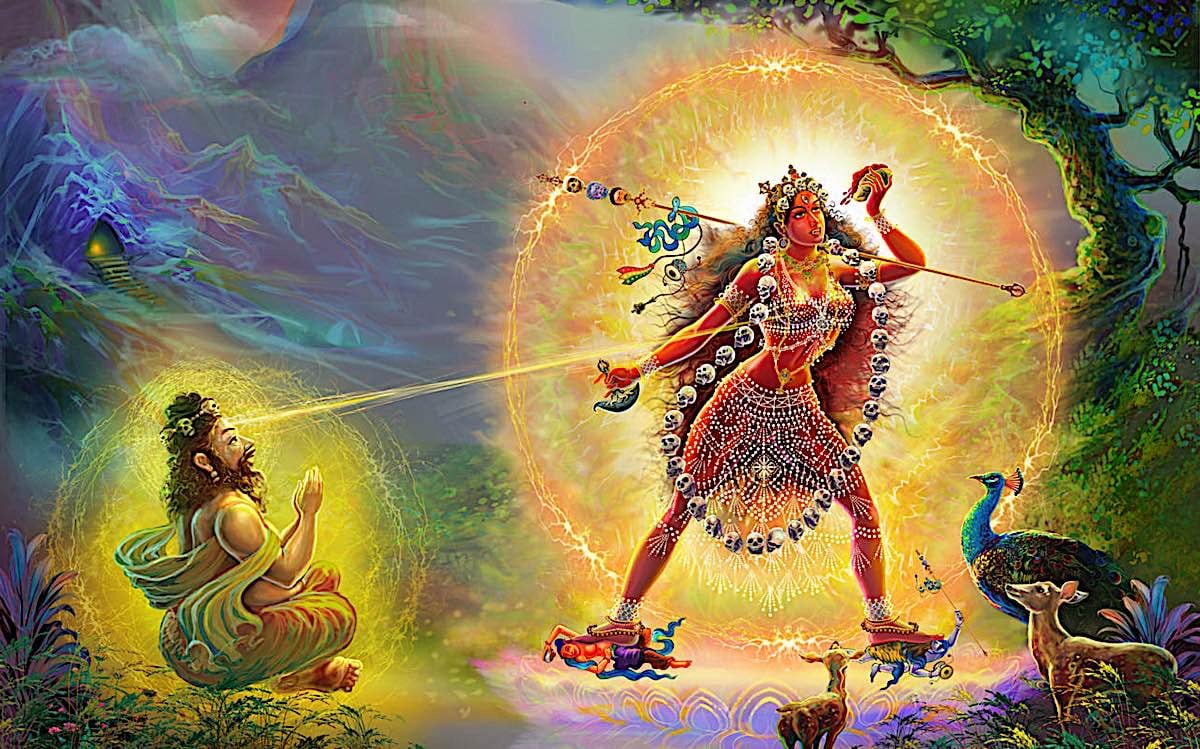
Our personal Yidam binds all concepts of Buddha and Enlightenment in one form that resonates perfectly for us. In the context of singular Yidam instruction, as famously taught by the great Lord Atisha, we could paraphrase as “One YIdam to rule them all.”
One Yidam to focus them all, One Yidam to manifest all, One Yidam to bring them all and in Emptiness transform them.
Single Yidam focuses us
Although we don’t seek to “bind” anything in darkness, the single-focus Yidam, or meditational hear practice, has the power to supercharge our accomplishments. (Remember, the Yidam is our practice!) Yidam is not a deity we worship — although we have devotion, of course — it’s a practice we undertake diligently to transform our minds.
From this point of view, it’s not entirely accurate to think of your Yidam as Buddha — even though a Yidam is an Enlightened Buddha. Yidam is actually the heart practice from our teacher that conveys the practice of Dharma. It is what we practice for our lifetime to achieve our own ultimate Enlightenment for the benefit of all beings.
We don’t have to have a Yidam. Many Buddhists don’t. Yet, as a method, like the One Ring in the epic fantasy, the one Yidam method is very powerful, empowering our meditations in a tangible, profound and rapid way. This is one reason Vajrayana is defined as the “Lightning” Path — “Vajra” literally translates lightning bolt, and “yana” means path. Why Lightning path as a metaphor. Lightning is both awesomely powerful and “speed of light” fast!
In meditational practices, nothing is more effective than a single focus. There is no one Yidam with the power to bind all the others — the bottom line is they are all, in essence, the same. We choose a Yidam that resonates with us.
Venerable Zasep Rinpoche describes our feeling for our Yidam as “passion, without attachment, even though the metaphor he used to explain the level of passion was of a child’s passion for a favorite toy. [See embedded video for more of this excellent 6-minute talk, ” How can we visualize Buddhas and Yidams — even if we have no imagination or skill at visualization?”
Rinpoche said, “So, when you have that, it’s like a child, a little child, fantasizing about toys. You go to the toy shop, and all you think about are toys. Like a little boy with his toy truck.
Automatically, boom, your mind is gone. Drawn in. Because you want this, you like this, you are so excited. Yogis, or Yoginis, should have this kind of excitement or passion.
That’s one of the purposes of Yidams. The Enlightened qualities of all the Buddhas are the same, but the visualized characteristics of one Yidam is different from another. We choose the one that “draws us us” like the child with his new toy.
As Zasep Rinpoche explains, that “with that inspiration that energy, then you can visualize — faster. That means your visualization skills will improve faster. Your concentration will improve.”
The great teacher Dzongsar Khyentse Rinpoche mirrored this level of enthusiasm when speaking about Tara:
The devotees of Tara, especially the devotees from great universities like as Nalanda, they go bananas. They long for her, they praise to her, they really supplicate, they beseech her.”
Longing and love and passion and wonder are methods. We need to praise, adore, pray, prostrate — not just for merit and purification, but to come closer to that ultimate truth that: “The deity is none other than the union of clarity and emptiness, the union of emptiness and compassion. [5]
“All Buddhas are One”
In the Avatamsaka Sutra, it says “All Buddhas are One Buddha.” Many of us have fragmented practices. One day we’re doing our Medicine Buddha Practice, the next day Tara, the next day, Manjushri — and on it goes. Also, One Buddha can have many forms, such as Avalokiteshvara, the Buddha of Compassion, who has wrathful, female, male and other forms suited to the minds of his practitioners:
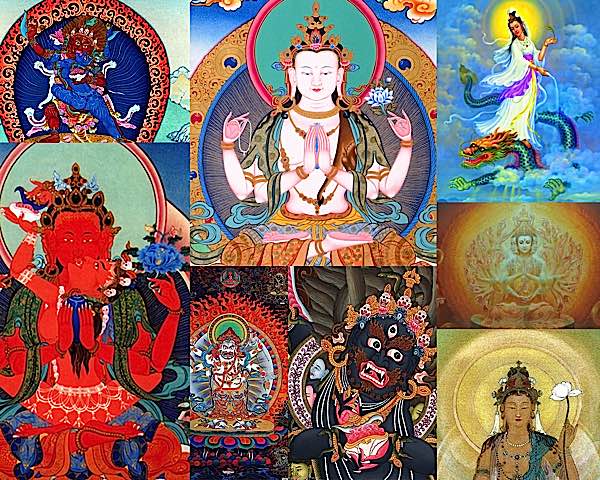
Padmasambhava, the Lotus Born master, likewise explained the concept that all Buddhas are of one essence, in a teaching to Lady Yeshe Tsogyal.
“The body, speech, and mind of all deities are manifested by the three kayas in accordance with the perception of those to be tamed. In fact, no matter how they appear, if you practice one you will be practicing them all. If you accomplish one you will have accomplished them all.”
He reinforced this further in answer to the Lady’s follow up question:
“Although the Sugatas manifest as various kinds of families and forms, out of skillful means to tame beings, they are in actuality inseparable, the state of equality.
If you were to practice all the Buddhas with this realization of their inseparability, your merit would be most eminent. But if you were to do so while regarding the yidam deities as having different qualities which should be either accepted or rejected, you would be immeasurably obscured.”
Why are there so many forms?
His Eminence Jamgon Kongtrul Rinpoche the Third.[2]
“Why are there so many? Yidams are visualized pure forms that manifest from dharmadhatu’s empty essence as the lucid self-display of our Lama’s compassion.” The goal of Yidam practice is critical to understanding these forms: ” What is the purpose of Vajrayana practice? Purifying one’s impure perception of all appearances and experiences.”
Skillful practice — choose one and only one!
Of course, most sophisticated meditators know the Enlightened qualities of one meditational deity are the same as all the others. No Yidam is more powerful than another. No Yidam is right for everyone. With skillful means, the Enlightened Buddhas can take any form. It is a symptom of our own fragmented mindstreams that we flit back and forth between one practice and another, even when our teachers tell us “one practice is all you need.” (One ring… okay, beating it to death…)
Somewhat less skillful is our practice. We are told by our teachers to choose one Yidam and focus for a lifetime on the practice — or until we attain realizations. That worked well in ancient India and Tibet, where great Maha-Siddhas choose one practice and devoted themselves with full focus. Today, our modern world, drives us this way and that way. One day we are bursting with enthusiasm to practice Vajrayogini. The next week we are excited to “try out” Yamantaka.
We should take to heart the advice the great Indian sage Atisha gave to the Tibetan master Rinchen Sangpo: “Some of you Tibetans have tried to accomplish a hundred deities but have failed to gain a single attainment, while some Indian Buddhists have gained the attainments of a hundred deities by accomplishing the practice of one.”
Zasep Rinpoche reinforced this idea in his short teaching (video):
You don’t need so many Yidams. That’s why Atisha said ‘It’s better to practice one Yidam.’ If you practice properly one Yidam and you achieve that, then you achieve all of them together.
Choosing your One Yidam
Guru Rinpoche advised Lady Yeshe Tosgyal how to choose a Yidam — and why there are so many forms:
“Since means and knowledge are practicing the spontaneously present body, speech, and mind through the method of yoga sadhana, all the countless sugatas, peaceful and wrathful, chief figures and retinues, manifest in accordance with those to be tamed in whichever way is necessary — as peaceful and wrathful, chief figures and retinues.
But as they are all of one taste in the state of dharmakaya, each person can practice whichever yidam he feels inclined toward.” [3]
The secret: remained focused on one Yidam
In other words, for each of us, individually, our “one ring” can be any Yidam — but the secret is to remain focused on one deity with all your heart, mind and focus.
Once we choose, and remain focused, as the late, great Gelek Rimpoche famously taught: “That is why you don’t have to think, ‘Yeah, I have Lama Vajrayogini here, but I have forgotten Shakyamuni, I forgot the Medicine Buddha, I forgot Tara there. What has happened to my refuge?”[2]
What is the Yidam ultimately?
Guru Rinpoche explained the nature of the Yidam, ultimately, to the Lady Yeshe Tsogyal:
“Realize that you and the yidam deity are not two and that there is no yidam deity apart from yourself. You approach the yidam deity when you realize that your nature is the state of nonarising dharmakaya.” [3]
NOTES
[1] Fellowship of the Ring, J.R.R. Tolkien
[2] See “Mind of One Buddha is the Mind of All Buddhas”
[3] Feature “Guru Rinpoche answers the Lady” on Buddha Weekly>>
[4] Feature “The mind of one Buddha is the Mind of All Buddhas” on Buddha Weekly>>
[5] Feature “Go Bananas for the Buddha” on Buddha Weekly>>
[6] Dakini Activity: The Dynamic Play of Awakening, by Padmsambhava, the Lotus Born. On Amazon — https://amzn.to/3nCSwVo (affiliate link.)
- Publisher : Rangjung Yeshe Publications (Sept. 27 2018)
- Language : English · Paperback : 194 pages · ISBN-10 : 0997716274 · ISBN-13 : 978-0997716276
More articles by this author

Guru Rinpoche is ready to answer and grant wishes: “Repeat this prayer continuously” for the granting of wishes

VIDEO: Vajrapani Vajra Armor Mantra: Supreme Protection of Dorje Godrab Vajrakavaca from Padmasambhava
Search
Latest Features
Please support the "Spread the Dharma" mission as one of our heroic Dharma Supporting Members, or with a one-time donation.
Please Help Support the “Spread the Dharma” Mission!

Be a part of the noble mission as a supporting member or a patron, or a volunteer contributor of content.
The power of Dharma to help sentient beings, in part, lies in ensuring access to Buddha’s precious Dharma — the mission of Buddha Weekly. We can’t do it without you!
A non-profit association since 2007, Buddha Weekly published many feature articles, videos, and, podcasts. Please consider supporting the mission to preserve and “Spread the Dharma." Your support as either a patron or a supporting member helps defray the high costs of producing quality Dharma content. Thank you! Learn more here, or become one of our super karma heroes on Patreon.
Lee Kane
Author | Buddha Weekly
Lee Kane is the editor of Buddha Weekly, since 2007. His main focuses as a writer are mindfulness techniques, meditation, Dharma and Sutra commentaries, Buddhist practices, international perspectives and traditions, Vajrayana, Mahayana, Zen. He also covers various events.
Lee also contributes as a writer to various other online magazines and blogs.








